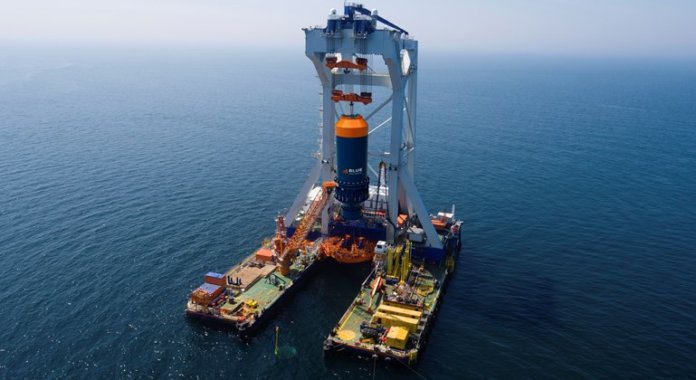The Carbon Trust has launched BLUE PILOT, a large-scale demonstration project aimed at reducing costs and underwater noise of offshore wind construction.
As part of the Carbon Trust’s Offshore Wind Accelerator (OWA) program, the BLUE PILOT project will deploy the BLUE Hammer, a new type of pile driver developed by Fistuca BV, a Dutch technology company. The project is expected to enable potential lifetime savings of up to EUR 33 million-40 million for a 720 MW offshore wind farm – which is equal to a levelized cost of energy reduction of 0.9-1.2 EUR/MWh.
OWA partners E.ON, EnBW, Ørsted, Statoil and Vattenfall – alongside additional industry partners Fistuca, Van Oord, Shell and Sif – are contributing EUR 3.2 million to the project. The Netherlands Enterprise Agency has also granted public subsidies of over EUR 2.5 million.
The BLUE Hammer is predicted to reduce underwater noise levels by up to 20 dB and potentially reduce fatigue damage during installation on the pile by up to 90%, says the Carbon Trust. This would not only remove the need for underwater noise mitigation but also enable secondary steel to be pre-welded to the monopile before installation, potentially unlocking “transition-piece-free” designs. Furthermore, by reducing the amount of time and number of operations carried out offshore, the innovative piling method would improve health and safety and result in a significantly lower installation cost, according to the Carbon Trust.
The BLUE PILOT project aims to verify these predictions through the offshore installation of a full-size monopile, using measurement equipment and sensors to validate the predicted noise levels and fatigue damage. The tests will take place this summer, and findings from the study will be made publically available later in the year.
The hammer will be tested at a location in Dutch waters. Sif will provide the monopile, and Van Oord will support the installation logistics. The other partners will provide funding and strategic advice into the project to ensure its relevance to future commercial projects.
“Statoil is constantly seeking to reduce the environmental impact and cost of our offshore wind projects. The Blue Piling technology has the potential to be an important contributor in this work, and we look forward together with the industry to develop this new technology,” says Rajnish Sharma, technology director of wind and low-carbon solutions at Statoil.
Fistuca BV developed the BLUE Hammer back in 2011. After a successful test of a smaller prototype in 2016, Fistuca BV secured an investment to manufacture a full-size hammer, capable of driving the largest monopiles currently available in the market.
The BLUE Hammer consists of a large water tank that contains an open combustion chamber. Energy for driving the pile is created with gas combustion that accelerates a large column of water. As the column of water falls back to the bottom of the water tank, it decelerates, transferring the energy into the pile. Due to the properties of water, this deceleration occurs over a longer time period than a conventional hydraulic hammer, providing a quieter and gentler but more energetic blow, according to the Carbon Trust.




